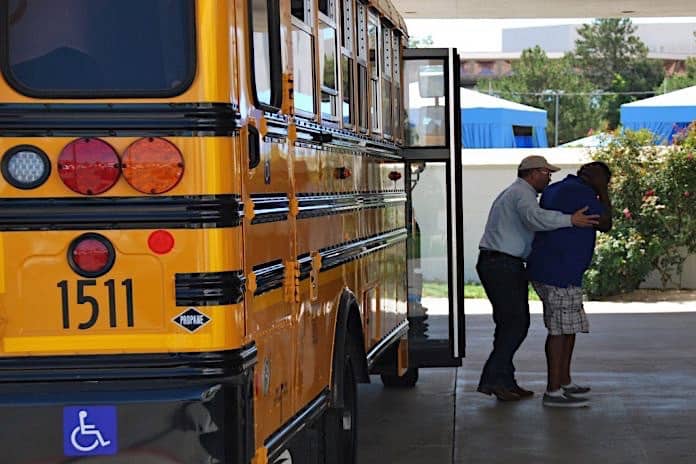RENO, Nev. — As the 22nd annual STN EXPO kicked off Saturday at the Grand Sierra Resort, child safety came to the forefront with two pre-conference workshops, the NHTSA Child Passenger Safety on School Buses and Writing a School Bus Evacuation Plan.
Getting children on and off a school bus in a safe manner during a crisis depends on a number of factors, two crucial ones being the evacuation plan a school district has in place and the training necessary to keep drivers current.
During the pre-conference workshop “Writing a School Bus Evacuation Plan,” attendees heard from three experts about how to prepare or revise the plans school districts have to evacuate buses.
Kathleen Furneaux, executive director of the Pupil Transportation Safety Institute, noted that there are “no absolutes” when handling a crisis and drivers need to rely on their training to make sure students remain safe. “Drivers must use the tools that they have,” said Furneaux.
The speakers had attendees participate in several discussions that examined the variety of situations where drivers would have to clear students safely off school buses, such as a bus fire, medical emergency or other threat.
One example dealt with students in wheelchairs and how drivers should remove them from the bus without hurting the student or themselves. Furneaux reiterated that in these situations, the primary goal is the student, not the wheelchair. “We aren’t in the business of saving wheelchairs,” she said. “Children are more important.”
Another example put forward the issue of buses approaching and crossing train tracks, as well as stalling on them. Denny Coughlin, a consultant for School Bus Training Company, emphasized that drivers need to be aware of their surroundings. “The number-one priority of trains is that they don’t want to hit school buses,” said Coughlin.
Additionally, Coughlin emphasized the importance of drivers thinking outside of the box when removing students from the bus as quickly and safely as possible, as well as maintaining open communication with dispatch during an emergency.
The best evacuation plan depends on transportation staff remaining updated on new technologies, such as GPS and routing programs, while also maintaining operational service to existing technology, according to Peter Lawrence, director of transportation for the Fairport Central School District.
Overall, each speaker stressed the importance of consistently training drivers, as well as monitors and aides, to properly de-escalate these critical situations in order to keep everyone alive at the end of the day.
The primary goal of the NHTSA Child Passenger Safety on School Buses session was also student safety. The eight-hour workshop explored the myriad issues and challenges of installing and using Child Safety Restraint Systems (CSRS).
Some of the topics discussed included the different types of CSRS, safety vests, lap belts and more.
The session, presented by Sue Shutrump, Charley Kennington and Kala Henkensiefken, offered valuable NHTSA-approved curriculum for student transporters who work with these types of systems. Attendees who completed the course received three continuing education units from Safe Kids Worldwide, an organization dedicated to preventing injuries in children.
Besides discussing how to properly secure a child in a CSRS, Shutrump pointed out that a child’s placement within a bus or other vehicle can also be crucial, particularly if a child has special needs. For example, students with respiratory problems should not sit next to the rear window, because they may be exposed to fumes and other things that could trigger asthma attacks and other problems.
“Something as simple as where they sit in the vehicle can make for a safe ride or a not safe ride,” she said.
Later in the session, Shutrump also discussed the proper use of safety vests as well as the importance of certain details about the safety vests, such as using this term instead of “harness.” She explained that some will argue that “harnesses are for dogs and horses,” and that using the term “safety vests” may make reluctant parents more comfortable with the idea of their children wearing them.
Shutrump also reiterated the importance of crotch straps in safety harnesses, because without these, a student may escape from the vest.
“I never use a safety vest without a crotch strap,” she said, adding that anyone using these vests without a crotch strap is “taking some real, real risks.”















